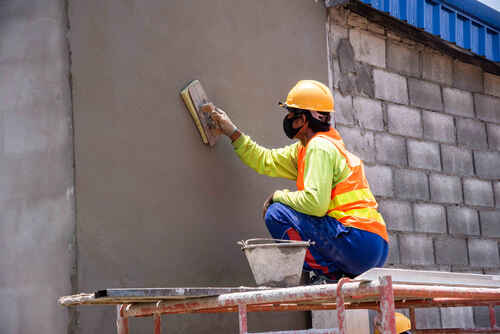A Comprehensive Overview to Learning Plastering Abilities for Your Renovation Needs

Necessary Devices and Materials
Various crucial devices serve distinctive purposes, making certain effectiveness and precision throughout the plastering process. A top notch trowel, for circumstances, is crucial for using and smoothing plaster, while a hawk offers a steady system for holding the material.
In addition to tools, selecting the ideal plastering products is important. Gypsum-based plasters are frequently preferred for their versatility and simplicity of usage, while cement-based alternatives are perfect for outside applications because of their resilience. Water and bonding agents play significant functions in accomplishing proper consistency and adhesion, making sure that the plaster sticks efficiently to the surface.
In addition, protective gear such as goggles, masks, and gloves is vital to protect versus dust and inflammation during the application process. By putting together the best combination of products and devices, plasterers can improve their ability collection and produce premium coatings, ultimately raising the total craftsmanship of their job.
Preparing Surfaces for Gluing
Achieving a resilient and smooth plaster coating begins with careful preparation of the surfaces to be smudged. This foundational action is important to making certain adhesion and the durability of the plaster. Begin by analyzing the problem of the substratum-- whether it is drywall, stonework, or concrete-- getting rid of any type of loose paint, dust, or particles that may interfere with bonding.
Next, repair any kind of flaws such as openings or splits. Use an ideal filler to attain a degree surface area; this can be critical for preventing future issues. As soon as repaired, ensure the surface is clean and dry, as moisture can endanger plaster adherence.
For porous surface areas, it is recommended to apply a bonding agent. This product boosts attachment and creates a trusted interface in between the plaster and substrate. If collaborating with formerly plastered surface areas, it may be required to scuff or sand the area lightly to provide a secret for the new plaster layer.
Plastering Techniques and Tips
Grasping smudging strategies calls for both skill and practice to achieve a remarkable coating. One crucial technique is the application of the plaster pop over here in numerous thin layers, as opposed to a single thick layer. This technique enables far better bond and lowers the danger of breaking. Beginning with a base coat, ensuring it is equally spread check over here out and leveled with a hawk and trowel. Utilize a straightedge to check for any imperfections before going on to subsequent layers.
When applying the coating coat, utilize a troweling technique that entails holding the trowel at a mild angle and working in a circular motion. This aids to produce a smooth surface and decreases the appearance of trowel marks. Additionally, maintain a spray container of water useful to mist the surface area lightly; this maintains the plaster practical and allows for smoother ending up.
Timing is essential; job efficiently, as the plaster begins to set. As soon as the plaster has actually tightened however is still moist, make use of a damp sponge to carefully smooth the surface area better. Last but not least, allow adequate drying out time before fining sand or painting, ensuring your effort causes an expert, high-quality surface.
Typical Mistakes to Stay Clear Of

One more usual mistake is applying plaster too thickly. Excitable applications can cause cracking and long term drying times. It's important to use plaster in slim, even layers, permitting each layer to dry adequately prior to including more.
Furthermore, Click This Link not making use of the right tools can prevent the top quality of the surface. Making use of inappropriate trowels or mixers can produce variances in the gluing process. Always go with top notch tools made for smudging tasks.
Finally, several people undervalue the importance of timing. Operating in unsuitable temperatures or moisture levels can negatively impact plaster treating and drying out. It is a good idea to examine climate conditions and adapt your timetable appropriately.
Ending Up Touches for a Professional Appearance
The last stages of a gluing job are important for attaining a polished, expert appearance. As soon as the plaster has actually dried adequately, the next step is to analyze the surface for flaws.
After sanding, it's suggested to clean the surface area to eliminate any type of dust and debris. A wet towel works for this objective, adhered to by a comprehensive drying period. If needed, using a thin layer of ending up plaster can boost the surface additionally, supplying a smooth surface.
As soon as the completing plaster is dry, one more round of fining sand might be required to attain the desired level of smoothness. Lastly, consider applying a primer prior to painting or wallpapering, which will certainly improve attachment and durability.
Final Thought
Mastering plastering skills considerably improves the quality of remodelling projects. A thorough understanding of important tools, surface preparation, and reliable methods is critical for accomplishing specialist outcomes.
Water and bonding representatives play considerable functions in accomplishing proper consistency and adhesion, making sure that the plaster sticks effectively to the surface area. Plastering.


In addition, maintain a spray container of water useful to haze the surface area lightly; this maintains the plaster practical and enables for smoother completing. (Plastering)
If needed, applying a thin layer of completing plaster can boost the surface even more, giving a smooth coating.
Comments on “Attractive Plastering: Add Unique Touches to Your Home's Interior”